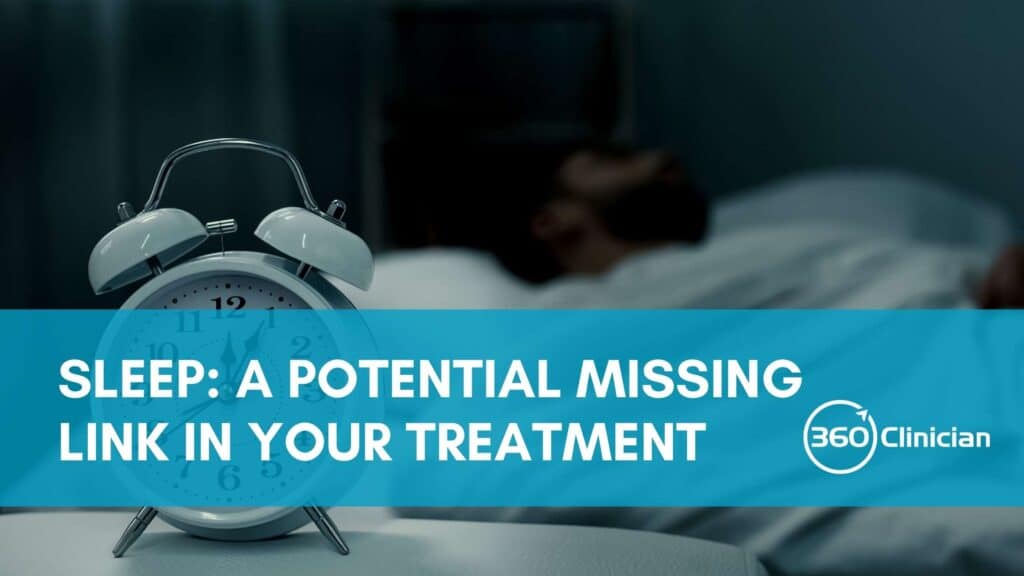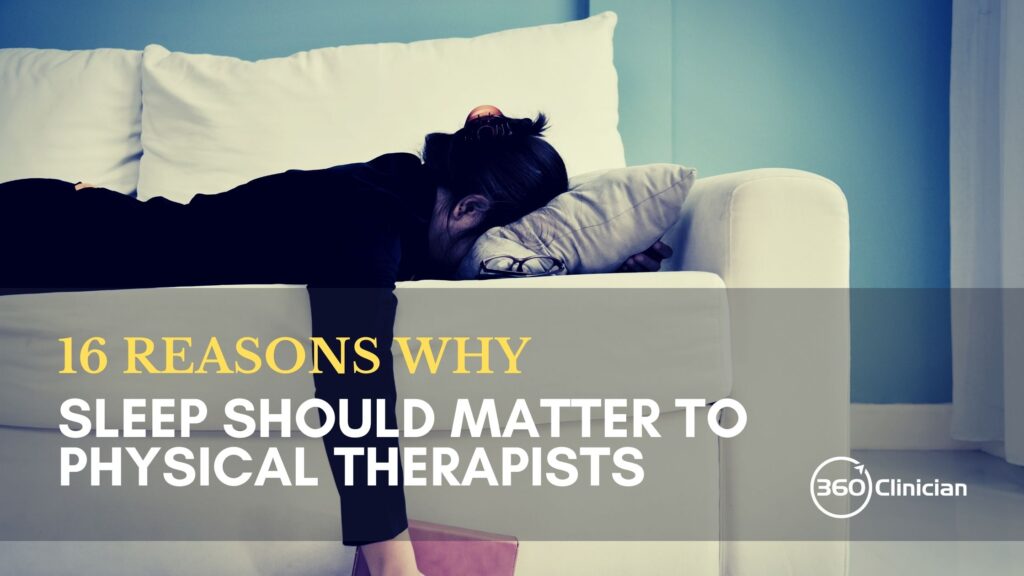We spend a third of our lives sleeping. Anyone who has experienced any disruption in sleep will attest to the far-reaching effects of broken sleep to all areas of functioning.
In this article, I would like to provide a brief overview for physiotherapists of insomnia, the most common sleep condition affecting people today, and then provide you four ways sleep can impact patient recovery.
Understanding Insomnia
Insomnia, the difficulty of falling and staying asleep, is the most common sleep condition in our society. The prevalence of insomnia is staggering; 50-70 million Americans experience disrupted sleep.[i] A survey of 2000 Canadians revealed 40% of respondents experienced one symptom of insomnia and almost 15% met all the standard criteria for insomnia.[ii] And a surprisingly large percentage (between 46% to 69%) of patients report of at least occasional insomnia when presenting in a primary care office setting.[iii]
Insomnia can be defined as someone who has trouble getting to sleep and staying asleep throughout the night. Although there are multiple definitions of insomnia depending on the classification system used (e.g. ICD-10, etc.), the DSM-V defines insomnia as:
- Difficulty initiating or maintaining sleep or early morning awakenings
- Distress or impairment from one’s insomnia
- At least three nights per week for more than three months
- Adequate opportunity for sleep[iv]
4 Ways Sleep Impacts Patient Recovery
#1: Chronic Sleep Deprivation Impacts General Health
Chronic insomnia has been found to have significant impacts on general health. In fact sleep researcher, Dr. Buxton has argued that sleep should be elevated in importance and be considered a third pillar in overall health. He writes:
“Increasing scientific evidence suggests that a public health focus should move beyond diet and exercise to include sleep as a third pillar of health and well-being in the fight against obesity and diabetes.”1
Chronic insomnia increases our risk of obesity, diabetes, hypertension among others. In a cross-sectional, retrospective study, researchers discovered that those with insomnia reported more medical problems than those without insomnia. In fact, the adjusted odds ratio (adjusting for depression, anxiety and other sleep disorder symptoms) of having any chronic medical problem was 5.17 times higher in those with insomnia than those without insomnia.[v] The following table[vi] highlights the increased prevalence of medical problems in those with insomnia:
| Medical Problem | Adjusted Odds Ratio |
| Heart Disease | 2.27 |
| Cancer | 2.58 |
| Hypertension | 3.18 |
| Neurological Disease | 4.64 |
| Breathing | 3.78 |
| Urinary | 1.80 |
| Chronic Pain | 3.19 |
| GI Problems | 3.33 |
In a meta-analysis of diabetes risk, researchers found that sleeping less than 6 hours per night resulted in a relative risk of 1.28 in developing diabetes. Interestingly, over-sleeping (>8-9 hours) also showed an increased risk profile (relative risk of 1.48). Ratios were adjusted to control for BMI, age, and other confounding factors.[vii]
#2 Poor Sleep is a Driver for Persistent Pain
In relation to pain, sleep is critical. Research shows that at least 50% of those with chronic pain complain of significant sleep problems with some studies showing as high as 70-88%![viii]
Intuitively it makes sense that pain can affect our sleep. An acute injury can leave us with fragmented sleep as pain easily evades our sleep experience. However, things become much more interesting when looking at the relationship between sleep and persistent pain. The research is still very much in its infancy, but it is showing that the relationship is not unidirectional. Not only does pain affect our sleep, but poor sleep can predispose us to pain.
In a 2008 study of the general population, research highlighted the relationship between sleep duration and following-day pain. Getting less than six hours (or more than nine hours) of sleep was associated with substantial increases in pain frequency the following day.[ix]
Sleep researchers highlight some interesting findings from various clinical studies as it relates to sleep and chronic pain:
- Poor sleep can lead to increased attention to pain during the day which can predict night-time sleep disturbance.
- Poor sleep quality and night awakenings predicted next morning pain in burn patients. However, day-time pain in these patients did not affect sleep.
- Pain and sleep disturbance were found to be long-term predictors of sleep disturbance in various studies.[x]
#3: Sleep Impacts Performance
Sleep deprivation impacts performance, both cognitive and motor function. Each year sleepiness contributes to hundreds of thousands of car accidents[xi] and interestingly staying awake for more than 20 hours impairs task performance to same degree as alcohol intoxication of 0.10% which is legally drunk in many jurisdictions.[xii]
Motor performance across the life span is something that as physiotherapists we are aware of. Sleep deprivation studies[xiii] highlight the impact on performance:
- 36 hours of sleep deprivation shows faster exhaustion (11% decrease) during treadmill walking test.
- Sleeping less than seven hours per night has been shown to decrease performance testing in alertness, reaction time, memory and decision making.
#4 Sleep Impacts Motivation
Physiotherapy treatment requires motivation to do home exercises and make lifestyle changes. The challenge is that disrupted sleep can wreak havoc with our motivation.
A quintessential sign of lack of motivation is depression. Sleep and depression are coupled together closely. In fact, those with insomnia are 10x more likely to have depression and 17x more likely to experience anxiety (as compared to normal sleepers).[xiv]
Conclusion
We’ve just touched on a few of the impacts of disrupted sleep on health. There are many more. But as you can see, sleep plays a significant role in key areas that are important in progressing our recovery and function. Even though we may feel stuck thinking that sleep hygiene rules are all one can use, think again. There is a strong body of evidence for behavioural treatment approaches that demonstrate recovery and remission of insomnia.
If you enjoyed this article and want to stay up-to-date on my newest content, sign up for the Clinical Flow Newsletter! There you will have access to special offers, exclusive content, and be part of a growing community of clinicians with the purpose of improving yourself and your clinical practice.
Resources
[i] Institute of Medicine. Sleep Disorders and Sleep Deprivation: An Unmet Public Health Problem. Washington, DC: The National Academies Press; 2006.
[ii] Morin, C. M., LeBlanc, M., LeBlanc, M., Bélanger, L., Bélanger, L., Ivers, H., et al. (2011). Prevalence of Insomnia and its Treatment in Canada. The Canadian Journal of Psychiatry, 56(9), 540–548. http://doi.org/10.1177/070674371105600905
[iii] Taylor, D. J., Mallory, L. J., Lichstein, K. L., Durrence, H. H., Riedel, B. W., & Bush, A. J. (2007). Comorbidity of chronic insomnia with medical problems. Sleep, 30(2), 213–218.)
[iv] Ong, J., Arnet, J., Gehrman, P. (2016). Insomnia diagnosis, assessment and evaluation. In Kryger, M., Roth, T., Dement, W. (Ed.) Principles and Practice of Sleep Medicine: 6th Ed. (pp. 785-793). St Louis: Elsevier.
[v] Lichstein, K. L., Taylor, D., McCrae, C., Ruiter, M. (2016) Insomnia: Epidemiology and risk factors. In Kryger et al (Ed.), Principles and practice of sleep medicine (6th ed.). (pp. 761-768). St. Louis, MO: Elsevier Saunders.
[vi] Taylor, D. J., Mallory, L. J., Lichstein, K. L., Durrence, H. H., Riedel, B. W., & Bush, A. J. (2007). Comorbidity of chronic insomnia with medical problems. Sleep, 30(2), 213–218.
[vii] Buxton, O., Broussard, J., Zahl, A, Hall, M.(2014). Effects of sleep deficiency on hormones, cytokines and metabolism. In Redline, S & Berger, N.A.(eds.), Impact of Sleep and Sleep Disturbances on Obesity and Cancer. (pp. 25-50). New York, NY: Springer.
[viii] Smith, M. T., & Haythornthwaite, J. A. (2004). How do sleep disturbance and chronic pain inter-relate? Insights from the longitudinal and cognitive-behavioral clinical trials literature. Sleep Medicine Reviews, 8(2), 119–132.
[ix] Edwards, R. R., Almeida, D. M., Klick, B., Haythornthwaite, J. A., & Smith, M. T. (2008). Duration of sleep contributes to next-day pain report in the general population☆. Pain, 137(1), 202–207. http://doi.org/10.1016/j.pain.2008.01.025
[x] Smith, M. T., & Haythornthwaite, J. A. (2004). How do sleep disturbance and chronic pain inter-relate? Insights from the longitudinal and cognitive-behavioral clinical trials literature. Sleep Medicine Reviews, 8(2), 119–132.
[xi] Royal, D. (2002) National survey of distracted and drowsy driving attitudes and behaviors: 2002. Vol. I: findings 2002 National Highway Traffic Safety Administration. Washington, DC. Available from: https://trid.trb.org/view.aspx?id=642633
[xii] Orzel-Gryglewska, J. (2010). Consequences of sleep deprivation. International Journal of Occupational Medicine and Environmental Health; 23(1): 95-114.
[xiii] Fullagar, H. H. K., Skorski, S., Duffield, R., Hammes, D., Coutts, A. J., & Meyer, T. (2014). Sleep and Athletic Performance: The Effects of Sleep Loss on Exercise Performance, and Physiological and Cognitive Responses to Exercise. Sports Medicine, 45(2), 161–186.
[xiv] Lichstein, K. L., Taylor, D., McCrae, C., Ruiter, M. (2016) Insomnia: Epidemiology and risk factors. In Kryger et al (Ed.), Principles and practice of sleep medicine (6th ed.). (pp. 761-768). St. Louis, MO: Elsevier Saunders.


